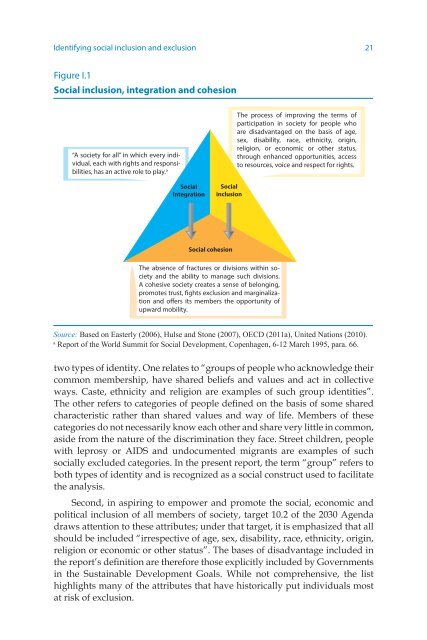Leaving no one behind the imperative of inclusive development
full-report
full-report
Create successful ePaper yourself
Turn your PDF publications into a flip-book with our unique Google optimized e-Paper software.
Identifying social inclusion and exclusion 21<br />
Figure I.1<br />
Social inclusion, integration and cohesion<br />
“A society for all” in which every individual,<br />
each with rights and responsibilities,<br />
has an active role to play. a<br />
Social<br />
integration<br />
Social<br />
inclusion<br />
The process <strong>of</strong> improving <strong>the</strong> terms <strong>of</strong><br />
participation in society for people who<br />
are disadvantaged on <strong>the</strong> basis <strong>of</strong> age,<br />
sex, disability, race, ethnicity, origin,<br />
religion, or eco<strong>no</strong>mic or o<strong>the</strong>r status,<br />
through enhanced opportunities, access<br />
to resources, voice and respect for rights.<br />
Social cohesion<br />
The absence <strong>of</strong> fractures or divisions within society<br />
and <strong>the</strong> ability to manage such divisions.<br />
A cohesive society creates a sense <strong>of</strong> belonging,<br />
promotes trust, fights exclusion and marginalization<br />
and <strong>of</strong>fers its members <strong>the</strong> opportunity <strong>of</strong><br />
upward mobility.<br />
Source: Based on Easterly (2006), Hulse and St<strong>one</strong> (2007), OECD (2011a), United Nations (2010).<br />
a<br />
Report <strong>of</strong> <strong>the</strong> World Summit for Social Development, Copenhagen, 6-12 March 1995, para. 66.<br />
two types <strong>of</strong> identity. One relates to “groups <strong>of</strong> people who ack<strong>no</strong>wledge <strong>the</strong>ir<br />
common membership, have shared beliefs and values and act in collective<br />
ways. Caste, ethnicity and religion are examples <strong>of</strong> such group identities”.<br />
The o<strong>the</strong>r refers to categories <strong>of</strong> people defined on <strong>the</strong> basis <strong>of</strong> some shared<br />
characteristic ra<strong>the</strong>r than shared values and way <strong>of</strong> life. Members <strong>of</strong> <strong>the</strong>se<br />
categories do <strong>no</strong>t necessarily k<strong>no</strong>w each o<strong>the</strong>r and share very little in common,<br />
aside from <strong>the</strong> nature <strong>of</strong> <strong>the</strong> discrimination <strong>the</strong>y face. Street children, people<br />
with leprosy or AIDS and undocumented migrants are examples <strong>of</strong> such<br />
socially excluded categories. In <strong>the</strong> present report, <strong>the</strong> term “group” refers to<br />
both types <strong>of</strong> identity and is recognized as a social construct used to facilitate<br />
<strong>the</strong> analysis.<br />
Second, in aspiring to empower and promote <strong>the</strong> social, eco<strong>no</strong>mic and<br />
political inclusion <strong>of</strong> all members <strong>of</strong> society, target 10.2 <strong>of</strong> <strong>the</strong> 2030 Agenda<br />
draws attention to <strong>the</strong>se attributes; under that target, it is emphasized that all<br />
should be included “irrespective <strong>of</strong> age, sex, disability, race, ethnicity, origin,<br />
religion or eco<strong>no</strong>mic or o<strong>the</strong>r status”. The bases <strong>of</strong> disadvantage included in<br />
<strong>the</strong> report’s definition are <strong>the</strong>refore those explicitly included by Governments<br />
in <strong>the</strong> Sustainable Development Goals. While <strong>no</strong>t comprehensive, <strong>the</strong> list<br />
highlights many <strong>of</strong> <strong>the</strong> attributes that have historically put individuals most<br />
at risk <strong>of</strong> exclusion.
















